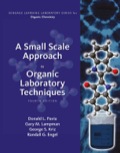
Concept explainers
(a)
Interpretation:
Appropriate solvent for the separation of
Concept introduction:
Thin layer chromatography or TLC is an analytical technique in which one can separate non-volatile components in a mixture based on polarity of chemical species. There, a sheet of glass, paper, etc. coated with the stationary phase is used which acts as the surface of adsorbent. The components in the sample (dissolved in a mobile phase) move through the stationary phase. Depending on the polarity of stationary phase, some components move faster than other.
Answer to Problem 1Q
Methylene chloride.
Explanation of Solution
(b)
Interpretation:
Appropriate solvent for the separation of bromobenzene and
Concept introduction:
Thin layer chromatography or TLC is an analytical technique in which one can separate non-volatile components in a mixture based on polarity of chemical species. There, a sheet of glass, paper, etc. coated with the stationary phase is used which acts as the surface of adsorbent. The components in the sample (dissolved in a mobile phase) move through the stationary phase. Depending on the polarity of stationary phase, some components move faster than other.
Answer to Problem 1Q
Hexane.
Explanation of Solution
Both compounds bromobenzene and
(c)
Interpretation:
Appropriate solvent for the separation of benzoic acid,
Concept introduction:
Thin layer chromatography or TLC is an analytical technique in which one can separate non-volatile components in a mixture based on polarity of chemical species. There, a sheet of glass, paper, etc. coated with the stationary phase is used which acts as the surface of adsorbent. The components in the sample (dissolved in a mobile phase) move through the stationary phase. Depending on the polarity of stationary phase, some components move faster than other.
Answer to Problem 1Q
Acetone.
Explanation of Solution
All three given compounds benzoic acid,
Want to see more full solutions like this?
Chapter 5 Solutions
EBK A SMALL SCALE APPROACH TO ORGANIC L
- Can the molecule on the right-hand side of this organic reaction be made in good yield from no more than two reactants, in one step, by moderately heating the reactants? ?A Δ O • If your answer is yes, then draw the reactant or reactants in the drawing area below. You can draw the reactants in any arrangement you like. • If your answer is no, check the box under the drawing area instead. Explanation Check Click and drag to start drawing a structure. 2025 McGraw Hill LLC. All Rights Reserved. Terms of Use | Privacy Center | Accessibilit ku F11arrow_forward१ eq ine teaching and × + rn/takeAssignment/takeCovalentActivity.do?locator-assignment-take [Review Topics] [References] Write an acceptable IUPAC name for the compound below. (Only systematic names, not common names are accepted by this question.) Keep the information page open for feedback reference. The IUPAC name is In progress mit Answer Retry Entire Group 5 more group attempts remaining Cengage Learning | Cengage Technical Support Save and Exitarrow_forwardDraw the molecules.arrow_forward
- Draw the mechanism for the acid-catalyzed dehydration of 2-methyl-hexan-2-ol with arrows please.arrow_forward. Draw the products for addition reactions (label as major or minor) of the reaction between 2-methyl-2-butene and with following reactants : Steps to follow : A. These are addition reactions you need to break a double bond and make two products if possible. B. As of Markovnikov rule the hydrogen should go to that double bond carbon which has more hydrogen to make stable products or major product. Here is the link for additional help : https://study.com/academy/answer/predict-the-major-and-minor-products-of-2-methyl- 2-butene-with-hbr-as-an-electrophilic-addition-reaction-include-the-intermediate- reactions.html H₂C CH3 H H3C CH3 2-methyl-2-butene CH3 Same structure CH3 IENCESarrow_forwardDraw everything on a piece of paper including every single step and each name provided using carbons less than 3 please.arrow_forward
- Topics] [References] Write an acceptable IUPAC name for the compound below. (Only systematic names, not common names are accepted by this question.) Keep the information page open for feedback reference. H The IUPAC name isarrow_forward[Review Topics] [References] Write an acceptable IUPAC name for the compound below. (Only systematic names, not common names are accepted by this question.) Keep the information page open for feedback reference. The IUPAC name is Submit Answer Retry Entire Group 9 more group attempts remainingarrow_forwardPlease draw.arrow_forward
- A chromatogram with ideal Gaussian bands has tR = 9.0 minutes and w1/2 = 2.0 minutes. Find the number of theoretical plates that are present, and calculate the height of each theoretical plate if the column is 10 centimeters long.arrow_forwardAn open tubular column has an inner diameter of 207 micrometers, and the thickness of the stationary phase on the inner wall is 0.50 micrometers. Unretained solute passes through in 63 seconds and a particular solute emerges at 433 seconds. Find the distribution constant for this solute and find the fraction of time spent in the stationary phase.arrow_forwardConsider a chromatography column in which Vs= Vm/5. Find the retention factor if Kd= 3 and Kd= 30.arrow_forward
 EBK A SMALL SCALE APPROACH TO ORGANIC LChemistryISBN:9781305446021Author:LampmanPublisher:CENGAGE LEARNING - CONSIGNMENT
EBK A SMALL SCALE APPROACH TO ORGANIC LChemistryISBN:9781305446021Author:LampmanPublisher:CENGAGE LEARNING - CONSIGNMENT
